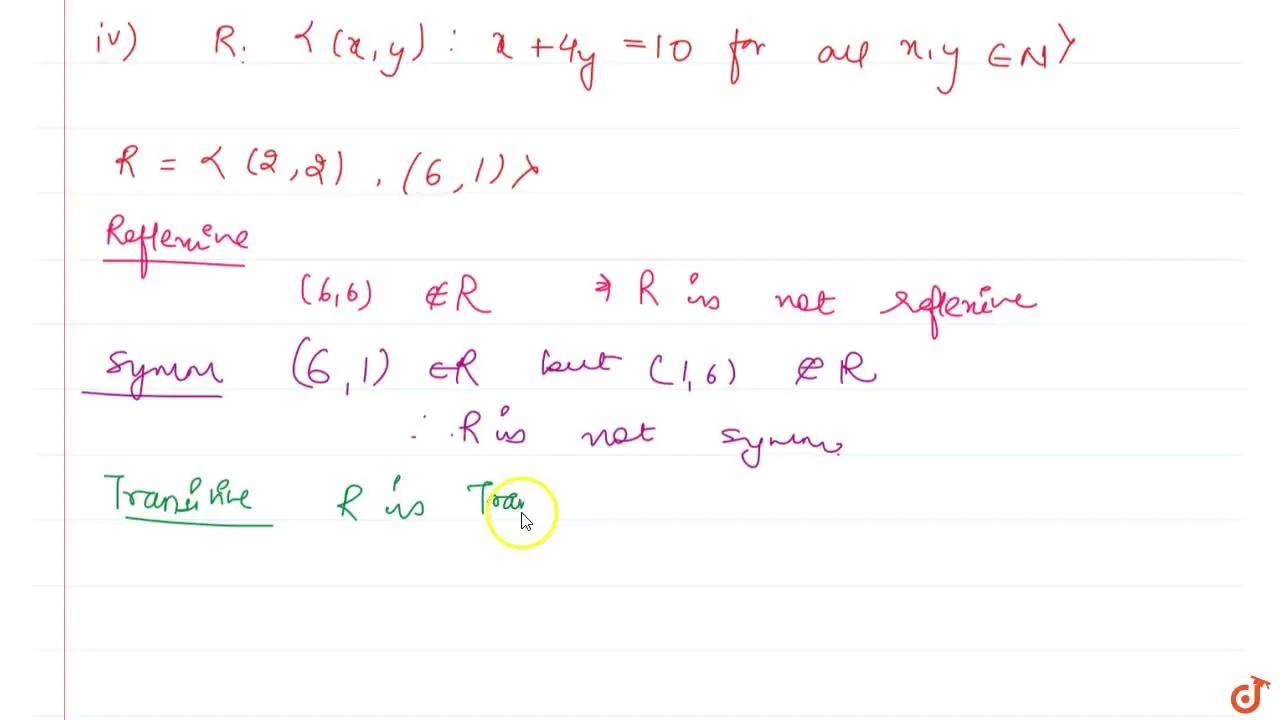Each of the following defines a relation on N:
(i)x>y, x, y∈N
(ii) x+y=10, x, y∈N
(iii) xy
is square of an integer, x, y∈N
(iv) x+4y=10, x, y∈N
Determine which of the above relations are
reflexive, symmetric and transitive.
(i) x is greater than y,x, y∈N
x is greater than y,x,y∈N
If (x,x)∈R, then x>x, which is not true for any x∈N.
Therefore, R is not reflexive.
Let (x,y)∈R
⇒ xRy
⇒x>y
⇒y>x, which is not true for any x;y∈N
Thus, R is not symmetric.
Let xRy and yRz
⇒ x>y and y>z
⇒x>z
⇒ xRz
So, R is transitive.
(ii) x+y=10;xy∈N
$$
\begin{aligned}
\therefore \quad R=&\{(x, y) ; x+y=10, x, y \in N\} \\
\therefore \quad R=&\{(1,9),(2,8),(3,7),(4,6),(5,5),\\
&(6,4),(7,3),(8,2),(9,1)\}
\end{aligned}
$$
Clearly (1,1)∉R
So, R is not reflexive.
$$
(x, y) \in R \Rightarrow(y, x) \in R
$$
Thus, R is symmetric.
Now (1,9)∈R,(9,1)∈R, but (1,1)∉R
Hence, R is not transitive.
(iii) Given xy, is square of an integer x,y∈N
∴R={(x,y):xy is a square of an integer x,y∈N}
Clearly (x,x)∈R,∀x∈N
As x2 is square of an integer for any x∈N
Hence, R is reflexive.
If (x,y)∈R⇒(y,x)∈R
So, R is symmetric
Now if xy is square of an integer and yz is square of an integer.
Then let xy=m2 and yz=n2 for some m,n∈Z
$$
\begin{aligned}
&\Rightarrow x=\frac{m^{2}}{y} \text { and } z=\frac{x^{2}}{y} \\
&\Rightarrow x z=\frac{m^{2} n^{2}}{y^{2}} \text {, which is square of an integer. }
\end{aligned}
$$
So, R is transitive.
\begin{equation}
\begin{aligned}
&\text { (iv) } x+4 y=10 ; x, y \in N \\
&\quad R=\{(x, y): x+4 y=10 ; x, y \in N\} \\
&\therefore \quad R=\{(2,2),(6,1)\} \\
&\text { Clearly }(1,1) \notin R \\
&\text { Thus, } R \text { is not reflexive. } \\
&\text { (6, } 1) \in R \text { but }(1,6) \notin R \\
&\text { Hence, } R \text { is not symmetric. } \\
&\quad(x, y) \in R \Rightarrow x+4 y=10 \\
&\text { and }(y, z) \in R \Rightarrow y+4 z=10 \\
&\Rightarrow \quad x-16 z=-30 \\
&\Rightarrow \quad(x, z) \notin R \\
&\text { So, } R \text { is not transitive. }
\end{aligned}
\end{equation}
Related Playlists
Similar Questions
Each of the following defines a relation on N: x→y,(i)x,y∈Nx+y=10x,∫e≥r,(iii)x , y in Nx+4y=10 ,x , y in N
View SolutionThe relation R defined as R={(x,y)|x+y|=10,x,y∈N} is
View SolutionLet N be the set of natural numbers and relation R on N be defined by R={(x,y):x,y∈N,x+4y=10} check whether R is reflexive , symmetric and transitive.
View SolutionThe domain and range of the relation R given by
R = {(x, y) : y = x + 6x , where x, y ∈ N and x < 6 } isView SolutionLet R be a relation defined on the set of natural numbers N as R={(x, y):x, y∈N, 2x+y=41} Find the domain and range of R . Also, verify whether R is (i) reflexive, (ii) symmetric (iii) transitive.
View SolutionFind the domain and range of the following relation R={(x,y):x∈N,x<6andy=4}
View SolutionLet R be a relation defined on the set of natural numbers N as R={(x,y):x,y∈N,2x+y=41} Find the domain and range of R. Also, verify whether R is (i) reflexive, (ii) symmetric (iii) transitive.
View SolutionLet S be the relation on N defined by:
S={(x,y):y2≤x≤2y}. Then S is:View SolutionR is a relation on N given by R = {(x,y) : 4x + 3y = 20}
Which of the following belongs to R ?View SolutionLet N be the set of integers. A relation R or N is defined as R={(x,y):xy>0,x,y,∈N}. Then, which one of the following is correct?
View Solution


